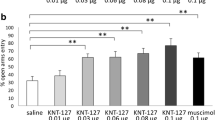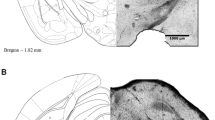Abstract
Studies have shown a close relationship between anxiety and aversive memory processing, but few animal models are suitable for investigating the effects of a given compound on anxiety and memory simultaneously. A growing body of evidence suggests anxiolytic and amnesic effects of nociceptin/orphanin FQ (N/OFQ). The mouse elevated T-maze (ETM) has been shown to detect the effects of drugs on anxiety and memory at the same time. In this study, the effects of intracerebroventricular N/OFQ injected before or immediately after training session were assessed in the ETM task. When pretraining injected, N/OFQ 0.1 nmol significantly decreased the latency to enter an open arm in the training session compared to control, which is suggestive of anxiolysis. In addition, N/OFQ (0.1 and 1 nmol) significantly reduced the latency to enter an open arm during the test session compared to control, thus suggesting memory impairments. However, when N/OFQ was administered posttraining, it did not affect memory retrieval. No alterations in locomotion were detected in N/OFQ-treated mice in the open field test. In conclusion, these findings are discussed considering the simultaneous anxiolytic and amnesic effects of N/OFQ.



Similar content being viewed by others
References
Asth L, Lobão-Soares B, André E, Soares VP, Gavioli EC (2012) The elevated T-maze task as an animal model to simultaneously investigate the effects of drugs on long-term memory and anxiety in mice. Brain Res Bull 87(6):526–533
Bridge KE, Wainwright A, Reilly K, Oliver KR (2003) Autoradiographic localization of (125)i[Tyr(14)] nociceptin/orphanin FQ binding sites in macaque primate CNS. Neuroscience 118(2):513–523
Bunzow JR, Saez C, Mortrud M, Bouvier C, Williams JT, Low M, Grandy DK (1994) Molecular cloning and tissue distribution of a putative member of the rat opioid receptor gene family that is not a mu, delta or kappa opioid receptor type. FEBS Lett 347(2–3):284–288
Carobrez AP, Bertoglio LJ (2005) Ethological and temporal analyses of anxiety-like behavior: the elevated plus-maze model 20 years on. Neurosci Biobehav Rev 29(8):1193–1205
Cruz-Morales SE, García-Saldívar NL, González-López MR, Castillo-Roberto G, Monroy J, Domínguez R (2008) Acute restriction impairs memory in the elevated T-maze (ETM) and modifies serotonergic activity in the dorsolateral striatum. Behav Brain Res 195(1):187–191
do Maia SC, Ferreira VM, Diniz JS, Carneiro FP, de Sousa JB, da Costa ET, Tomaz C (2010) Inhibitory avoidance acquisition in adult rats exposed to a combination of ethanol and methylmercury during central nervous system development. Behav Brain Res 211(2):191–197
Duzzioni M, Duarte FS, Leme LR, Gavioli EC, De Lima TC (2011) Anxiolytic-like effect of central administration of NOP receptor antagonist UFP-101 in rats submitted to the elevated T-maze. Behav Brain Res 222(1):206–211
Florin S, Meunier J, Costentin J (2000) Autoradiographic localization of [3H]nociceptin binding sites in the rat brain. Brain Res 880(1–2):11–16
Fornari RV, Soares JC, Ferreira TL, Moreira KM, Oliveira MG (2008) Effects of nociceptin/orphanin FQ in the acquisition of contextual and tone fear conditioning in rats. Behav Neurosci 122(1):98–106
Fukuda K, Kato S, Mori K, Nishi M, Takeshima H, Iwabe N, Miyata T, Houtani T, Sugimoto T (1994) cDNA cloning and regional distribution of a novel member of the opioid receptor family. FEBS Lett 343(1):42–46
Gavioli EC, Calo; G (2006) Antidepressant- and anxiolytic-like effects of nociceptin/orphanin FQ receptor ligands. Naunyn Schmiedebergs Arch Pharmacol 372(5):319–330
Gavioli EC, Rae GA, Calo’ G, Guerrini R, De Lima TC (2002) Central injections of nocistatin or its C-terminal hexapeptide exert anxiogenic-like effect on behaviour of mice in the plus-maze test. Br J Pharmacol 136(5):764–772
Goeldner C, Reiss D, Wichmann J, Meziane H, Kieffer BL, Ouagazzal AM (2008) Nociceptin receptor impairs recognition memory via interaction with NMDA receptor-dependent mitogen-activated protein kinase/extracellular signal-regulated kinase signaling in the hippocampus. J Neurosci 28(9):2190–2198
Graeff FG, Viana MB, Tomaz C (1993) The elevated T maze, a new experimental model of anxiety and memory: effect of diazepam. Braz J Med Biol Res 26(1):67–70
Graeff FG, Viana MB, Mora P (1996) Opposed regulation by dorsal raphe nucleus 5-HT pathways of two types of fear in the elevated T-maze. Pharmacol Biochem Behav 53:171–177
Graeff FG, Netto CF, Zangrossi H (1998) The elevated T-maze as an experimental model of anxiety. Neurosci Biobehav Rev 23(2):237–246
Griebel G, Blanchard DC, Jung A, Blanchard RJ (1995) A model of ‘antipredator’ defense in Swiss–Webster mice: effects of benzodiazepine receptor ligands with different intrinsic activities. Behav Pharmacol 6:732–745
Griebel G, Perrault G, Sanger DJ (1999) Orphanin FQ, a novel neuropeptide with anti-stress-like activity. Brain Res 836(1–2):221–224
Guerrini R, Calo G, Rizzi A, Bianchi C, Lazarus LH, Salvadori S, Temussi PA, Regoli D (1997) Address and message sequences for the nociceptin receptor: a structure-activity study of nociceptin-(1–13)-peptide amide. J Med Chem 40(12):1789–1793
Handley SL (1991) Serotonin in animal models of anxiety: the importance of stimulus and response. In: Idzidowzki C, Cowen PJ (eds) Serotonin, sleep and mental disorder. Wrightson Biomedical, Petersfield, pp 89–115
Handley SL, McBlane JW (1993) An assessment of the elevated X-maze for studying anxiety and anxiety-modulating drugs. J Pharmacol Toxicol Methods 29:129–138
Higgins GA, Kew JN, Richards JG, Takeshima H, Jenck F, Adam G, Wichmann J, Kemp JA, Grottick AJ (2002) A combined pharmacological and genetic approach to investigate the role of orphanin FQ in learning and memory. Eur J Neurosci 15(5):911–922
Hiramatsu M, Inoue K (1999) Effects of nocistatin on nociceptin-induced impairment of learning and memory in mice. Eur J Pharmacol 367(2–3):151–155
Jardim MC, Nogueira RL, Graeff FG, Nunes-de-Souza RL (1999) Evaluation of the elevated T-maze as an animal model of anxiety in the mouse. Brain Res Bull 48(4):407–411
Jenck F, Moreau JL, Martin JR, Kilpatrick GJ, Reinscheid RK, Monsma FJ, Nothacker HP, Civelli O (1997) Orphanin FQ acts as an anxiolytic to attenuate behavioral responses to stress. Proc Natl Acad Sci U S A 94(26):14854–14858
Kamei J, Matsunawa Y, Miyata S, Tanaka S, Saitoh A (2004) Effects of nociceptin on the exploratory behavior of mice in the hole-board test. Eur J Pharmacol 489(1–2):77–87
Kuzmin A, Madjid N, Johansson B, Terenius L, Ogren SO (2009) The nociceptin system and hippocampal cognition in mice: a pharmacological and genetic analysis. Brain Res 1305(Suppl):S7–S19
Lachowicz JE, Shen Y, Monsma FJ, Sibley DR (1995) Molecular cloning of a novel G protein-coupled receptor related to the opiate receptor family. J Neurochem 64(1):34–40
LeDoux JE (1993) Emotional memory systems in the brain. Behav Brain Res 58(1–2):69–79
Mamiya T, Noda Y, Nishi M, Takeshima H, Nabeshima T (1999) Nociceptin system plays a role in the memory retention: involvement of naloxone benzoylhydrazone binding sites. Neuroreport 10(6):1171–1175
Meunier JC, Mollereau C, Toll L, Suadeau C, Moisand C, Alvinerie P, Butour JL, Guillemot JC, Ferrara P, Monserrat B, Mazarguil H, Vassart G, Parmentier M, Costentin J (1995) Isolation and structure of the endogenous agonist of opioid receptor-like ORL1 receptor. Nature 377:532–535
Mogil JS, Pasternak GW (2001) The molecular and behavioral pharmacology of the orphanin FQ/nociceptin peptide and receptor family. Pharmacol Rev 53(3):381–415
Montgomery KC (1955) The relation between fear induced by novel stimulation and exploratory behavior. J Comp Physiol Psychol 4:254–260
Neal CR, Mansour A, Reinscheid R, Nothacker HP, Civelli O, Akil H, Watson SJ Jr (1999a) Opioid receptor-like (ORL1) receptor distribution in the rat central nervous system: comparison of ORL1 receptor mRNA expression with (125)I-[(14)Tyr]-orphanin FQ binding. J Comp Neurol 412(4):563–605
Neal CR, Mansour A, Reinscheid R, Nothacker HP, Civelli O, Watson SJ (1999b) Localization of orphanin FQ (nociceptin) peptide and messenger RNA in the central nervous system of the rat. J Comp Neurol 406(4):503–547
Noda Y, Mamiya T, Manabe T, Nishi M, Takeshima H, Nabeshima T (2000) Role of nociceptin systems in learning and memory. Peptides 21(7):1063–1069
Paxinos G, Franklin KBJ (2008) The mouse brain in stereotaxic coordinates, 3rd edn. Academic, San Diego
Pellow S, Chopin P, File SE, Briley M (1985) Validation of open:closed arm entries in an elevated plus-maze as a measure of anxiety in the rat. J Neurosci Methods 14(3):149–167
Redrobe JP, Calo G, Guerrini R, Regoli D, Quirion R (2000) [Nphe(1)]-Nociceptin (1–13)-NH(2), a nociceptin receptor antagonist, reverses nociceptin-induced spatial memory impairments in the Morris water maze task in rats. Br J Pharmacol 131(7):1379–1384
Reinscheid RK, Nothacker HP, Bourson A, Ardati A, Henningsen RA, Bunzow JR, Grandy DK, Langen H, Monsma FJ, Civelli O (1995) Orphanin FQ: a neuropeptide that activates an opioid-like G protein-coupled receptor. Science 270:792–794
Rodgers RJ, Cao BJ, Dalvi A, Holmes A (1997) Animal models of anxiety: an ethological perspective. Braz J Med Biol Res 30(3):289–304
Roozendaal B, Lengvilas R, McGaugh JL, Civelli O, Reinscheid RK (2007) Orphanin FQ/nociceptin interacts with the basolateral amygdala noradrenergic system in memory consolidation. Learn Mem 14(1–2):29–35
Ruzza C, Pulga A, Rizzi A, Marzola G, Guerrini R, Calo’ G (2012) Behavioural phenotypic characterization of CD-1 mice lacking the neuropeptide S receptor. Neuropharmacology 62(5–6):1999–2009
Sandin J, Georgieva J, Schött PA, Ogren SO, Terenius L (1997) Nociceptin/orphanin FQ microinjected in hippocampus impairs spatial learning in rats. Eur J Neurosci 9(1):194–197
Santos P, Bittencourt AS, Schenberg LC, Carobrez AP (2006) Elevated T-maze evaluation of anxiety and memory effects of NMDA/glycine-B site ligands injected in the dorsal periaqueductal gray matter and the superior colliculus of rats. Neuropharmacology 51(2):203–212
Takahashi RN, Pamplona FA, Fernandes MS (2005) The cannabinoid antagonist SR141716A facilitates memory acquisition and consolidation in the mouse elevated T-maze. Neurosci Lett 380(3):270–275
Teixeira RC, Zangrossi H, Graeff FG (2000) Behavioral effects of acute and chronic imipramine in the elevated T-maze model of anxiety. Pharmacol Biochem Behav 65(4):571–576
Uchiyama H, Toda A, Hiranita T, Watanabe S, Eyanagi R (2008) Role of amygdaloid nuclei in the anxiolytic-like effect of nociceptin/orphanin FQ in rats. Neurosci Lett 431(1):66–70
Viana MB, Tomaz C, Graeff FG (1994) The elevated T-maze: a new animal model of anxiety and memory. Pharmacol Biochem Behav 49:549–554
Viana MB, Graeff FG, Loschmann PA (1997) Kainate microinjection into the dorsal raphe nucleus induces 5-HT release in the amygdala and periaqueductal gray. Pharmacol Biochem Behav 58:167–172
Vitale G, Arletti R, Ruggieri V, Cifani C, Massi M (2006) Anxiolytic-like effects of nociceptin/orphanin FQ in the elevated plus maze and in the conditioned defensive burying test in rats. Peptides 27(9):2193–2200
Witkin JM, Statnick MA, Rorick-Kehn LM, Pintar JE, Ansonoff M, Chen Y, Tucker RC, Ciccocioppo R (2014) The biology of Nociceptin/Orphanin FQ (N/OFQ) related to obesity, stress, anxiety, mood, and drug dependence. Pharmacol Ther 141(3):283–299
Zangrossi H, Graeff FG (1997) Behavioral validation of the elevated T-maze, a new animal model of anxiety. Brain Res Bull 44(1):1–5
Zanoveli JM, Nogueira RL, Zangrossi H (2003) Serotonin in the dorsal periaqueductal gray modulates inhibitory avoidance and one-way escape behaviors in the elevated T-maze. Eur J Pharmacol 473(2–3):153–161
Acknowledgments
This work was supported by funds from the Brazilian National Council Research (grant no. 476832/2009-8 and 305742/2009-4 to EC Gavioli). L Asth was recipient of a MSc scholarship from the Brazilian National Research Council.
Conflict of interest
The authors declare no competing financial interests.
Ethical standards
The manuscript does not contain clinical studies or patient data.
Author information
Authors and Affiliations
Corresponding author
Rights and permissions
About this article
Cite this article
Asth, L., Correia, N., Lobão-Soares, B. et al. Nociceptin/orphanin FQ induces simultaneously anxiolytic and amnesic effects in the mouse elevated T-maze task. Naunyn-Schmiedeberg's Arch Pharmacol 388, 33–41 (2015). https://doi.org/10.1007/s00210-014-1055-4
Received:
Accepted:
Published:
Issue Date:
DOI: https://doi.org/10.1007/s00210-014-1055-4




